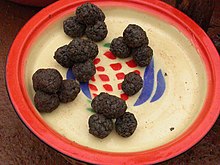Parkia biglobosa
| Parkia biglobosa | ||||||||||||
|---|---|---|---|---|---|---|---|---|---|---|---|---|

Parkia biglobosa |
||||||||||||
| Systematics | ||||||||||||
|
||||||||||||
| Scientific name | ||||||||||||
| Parkia biglobosa | ||||||||||||
| (Jacq.) R.Br. ex G.Don |
Parkia biglobosa (Jacq.) R. Br. Ex G. Don ( Syn. Parkia clappertoniana Keay ) is a species of the genus Parkia within the legume family (Fabaceae). Its natural distribution ranges from Senegal to Sudan , where it iscalled Néré .
description
Parkia biglobosa grows as a deciduous tree with a spreading crown and reaches heights of up to 20-30 meters. The trunk diameter can reach 130 centimeters. The peculiarity of this tree is that it does not lose its leaves even in the dry season . It often forms a taproot with far-reaching side roots. This improves the microclimate between the trees. The tree is therefore often associated with the shea tree .
The alternate, stalked leaves are bipinnate, with many small, sessile leaflets . The rachis has a sloping tip. The stipules are missing.
The hermaphroditic, male, nectar-producing and, at the bottom, the sterile, five-fold flowers with a double, tubular flower envelope stand together on long drooping inflorescence shafts, in round, about 5–6.5 centimeters large, bright red, many-flowered heads . The hermaphrodite flowers at the tip included 10 long stamens and a top permanent ovary with long stylus . The smaller male flowers have shorter stamens, the sterile ones have stunted stamens. They are pollinated by bats .
Accordingly, the up to 20–40 cm long, 1.5–2.5 cm wide, many-seeded, smooth and bare, flat, brown legumes hang in groups on the head. The seeds with the pleurogram are smooth, hard and shiny, dark brown, and about 1–1.5 centimeters in size.
Occurrence
Parkia biglobosa thrives in the Sudanese savannas. Its natural distribution ranges from Senegal to Sudan . In addition, it was also introduced to the West Indies .
use
The fruit seeds, which are rich in proteins and minerals , are fermented and used as a spice ( soumbala ) for soups and sauces. The juice obtained from the yellow, floury and very sugary pulp is used for drinks and also for impregnating clay plaster against moisture and rain. Therefore the Néré is an important useful tree; it is often left out when clearing for new fields and is thus a typical element of the Sudanese cultural tree parks .
Processing Néré seeds can make a profitable small business acquisition possible. However, access to peeling machines is often a bottleneck, for example in Mali. When it comes to the demand for soumbala, it must be taken into account that cheaper substitutes are increasingly displacing the nutrient-rich Néré-based soumbala: for example, soybean-based spicy sauces or industrially produced stock cubes.
Due to its shadow effect, special crops are grown under the Néré. Okra , ground peas and peanuts are grown in beds under the tree.
The yellow, floury fruit pulp can also be eaten.
literature
- S. Ouedraoga: Parkia biglobosa en Afrique de l'Ouest . Wageningen 1995, Landbouwuniv., Diss. 205 S., ISBN 90-5485-365-4
- Thomas Krings , Sahelländer, WBG-Länderkunden, Wissenschaftliche Buchgesellschaft Darmstadt, 2006, ISBN 3-534-11860-X
Web links
- Parkia biglobosa . In: U. Brunken, M. Schmidt, S. Dressler, T. Janssen, A. Thiombiano, G. Zizka: West African plants - A Photo Guide. Senckenberg Research Institute, Frankfurt am Main 2008.

